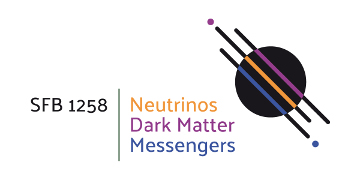Victoria Wagner (TUM): At the 100 eV Frontier: "Calibration Techniques for Neutrino Physics with NUCLEUS"
Coherent elastic neutrino nucleus scattering (CEvNS) offers a unique way to study neutrino properties and to search for new physics beyond the Standard Model. The NUCLEUS experiment aims to measure CEvNS of reactor anti-neutrinos down to unprecedented low nuclear recoil energies. The use of novel gram-scale fiducial-volume cryogenic detectors promises a high physics potential, already with a 10 g target array deployed at a new experimental site at the Chooz nuclear power plant.
With an ultra-low energy threshold of 20 eV, NUCLEUS enters an energy range for which an absolute energy calibration is yet missing. The CRAB project proposes a method based on nuclear recoils induced by the emission of an MeV-gamma following thermal neutron capture. Detailed feasibility studies show that this method yields distinct nuclear recoil calibration peaks at 112 eV and 160 eV for tungsten. In the first phase, the CRAB project foresees to perform a nuclear recoil calibration of cryogenic CaWO4 detectors read out by TES, similar to the detectors used in CRESST and NUCLEUS. The low-power TRIGA reactor in Vienna provides a clean beam of thermal neutrons well suited for such a measurement. In the second phase, additional tagging of photons produced in the de-excitation process will allow extending the calibration method to even lower energies and to a wider range of detector materials, such as Ge.
In this talk, I will review the physics potential of NUCLEUS and its current status, especially the plans for the commissioning of the full experimental setup at TUM in 2022. Furthermore, I will highlight the necessity of a low energy nuclear recoil calibration of CaWO4, and how this challenging task is tackled within the CRAB project.
Andrea Caputo, TAU & Weizmann Institute of Science: "Muonic Boson Limits: Supernova Redux"
Core-collapse supernovae are efficient laboratories to explore physics beyond the standard model (SM). In particular, they have been used to put strong constraints on axion and axion like particles, and on many other motivated extensions of the SM. In this talk I will introduce the subject and then focus on new results for muon-philic interactions. These results are particularly timing given the recent confirmation of the muon magnetic moment anomaly, which now stands at more than 4 sigma significance and may be a clear sign of violation of flavor universality.
I will conclude the talk with future directions, which will surely profit by a tighter collaboration between the astrophysics and the particle physics communities.
---
On Zoom:
https://tum-conf.zoom.us/j/64041263874
Meeting ID: 640 4126 3874
Passcode: 1258-2


